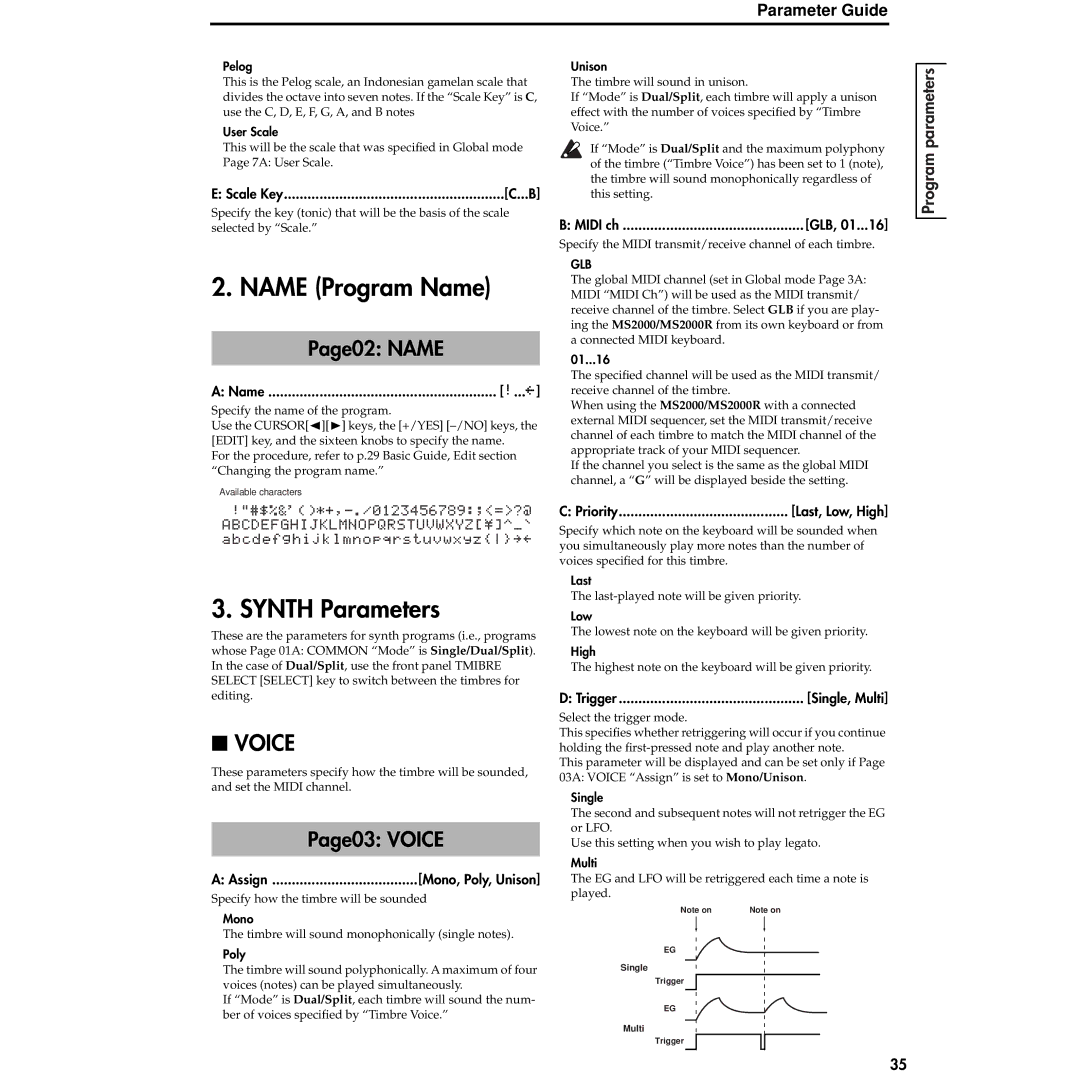
Parameter Guide
Pelog
This is the Pelog scale, an Indonesian gamelan scale that divides the octave into seven notes. If the “Scale Key” is C, use the C, D, E, F, G, A, and B notes
User Scale
This will be the scale that was specified in Global mode Page 7A: User Scale.
E: Scale Key | [C...B] |
Specify the key (tonic) that will be the basis of the scale selected by “Scale.”
2. NAME (Program Name)
Page02: NAME
A: Name | [!...’] |
Specify the name of the program.
Use the CURSOR[√][®] keys, the [+/YES]
For the procedure, refer to p.29 Basic Guide, Edit section “Changing the program name.”
Available characters
Unison
The timbre will sound in unison.
If “Mode” is Dual/Split, each timbre will apply a unison effect with the number of voices specified by “Timbre Voice.”
If “Mode” is Dual/Split and the maximum polyphony of the timbre (“Timbre Voice”) has been set to 1 (note), the timbre will sound monophonically regardless of this setting.
B: MIDI ch | [GLB, 01...16] |
Specify the MIDI transmit/receive channel of each timbre.
GLB
The global MIDI channel (set in Global mode Page 3A: MIDI “MIDI Ch”) will be used as the MIDI transmit/ receive channel of the timbre. Select GLB if you are play- ing the MS2000/MS2000R from its own keyboard or from a connected MIDI keyboard.
01...16
The specified channel will be used as the MIDI transmit/ receive channel of the timbre.
When using the MS2000/MS2000R with a connected external MIDI sequencer, set the MIDI transmit/receive channel of each timbre to match the MIDI channel of the appropriate track of your MIDI sequencer.
If the channel you select is the same as the global MIDI channel, a “G” will be displayed beside the setting.
Program parameters
ABCDEFGHIJKLMNOPQRSTUVWXYZ[\]^_“ abcdefghijklmnopqrstuvwxyz{}”’
3. SYNTH Parameters
These are the parameters for synth programs (i.e., programs whose Page 01A: COMMON “Mode” is Single/Dual/Split). In the case of Dual/Split, use the front panel TMIBRE SELECT [SELECT] key to switch between the timbres for editing.
■VOICE
These parameters specify how the timbre will be sounded, and set the MIDI channel.
Page03: VOICE
A: Assign | [Mono, Poly, Unison] |
Specify how the timbre will be sounded
Mono
The timbre will sound monophonically (single notes).
Poly
The timbre will sound polyphonically. A maximum of four voices (notes) can be played simultaneously.
If “Mode” is Dual/Split, each timbre will sound the num- ber of voices specified by “Timbre Voice.”
C: Priority | [Last, Low, High] |
Specify which note on the keyboard will be sounded when you simultaneously play more notes than the number of voices specified for this timbre.
Last
The
Low
The lowest note on the keyboard will be given priority.
High
The highest note on the keyboard will be given priority.
D: Trigger | [Single, Multi] |
Select the trigger mode.
This specifies whether retriggering will occur if you continue holding the
This parameter will be displayed and can be set only if Page 03A: VOICE “Assign” is set to Mono/Unison.
Single
The second and subsequent notes will not retrigger the EG or LFO.
Use this setting when you wish to play legato.
Multi
The EG and LFO will be retriggered each time a note is played.
Note on | Note on |
EG
Single
Trigger
EG
Multi
Trigger
35
